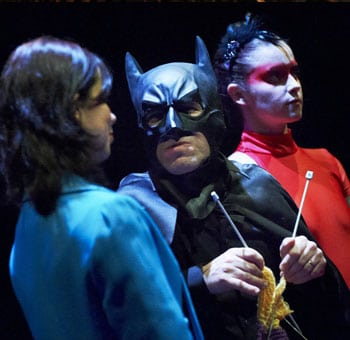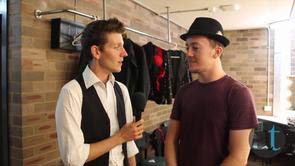A Doll House

Pan Pan Theatre’s A Doll House defies description as it re-imagines Ibsen’s timeless tale of disillusionment and self-determination by redefining the boundaries of play.
The audience is greeted by larger than life paper-dolls of the characters with their backs turned. They are lifeless and inanimate, waiting for words to be put into their mouths and movement into their bodies. Aine Helen (simultaneously playing various roles including nanny and children) enters and describes the imminent scene, offering an interpretation; she enunciates the stage directions, giving voice to the presence of a master puppeteer. The live dolls enter and the play (determined by Director Gavin Quinn) begins; for you see the purpose of staging A Doll House, is not to reflect on Ibsen’s classic tale, but to reflect on the evolution of the language of theatre, the language with which meaning is conveyed to an audience. The choice of Ibsen’s text is really a clever double entendre that gives the company a way to bring their explorations to the stage – yes Ibsen’s message is still sadly relevant, but his style not so. Pan Pan Theatre asks audiences to watch them play with Ibsen’s dolls, to define what a Christmas tree looks like and as the second act opens with the paper dolls turned to face the audience, they ask us to consider our own role in this game – are we also dolls in this make-believe house?
As for Ibsen’s text, it’s mostly intact; Nora Helmer (played to manic perfection by Judith Roddy) slowly realises that she has been conditioned all her life to exist as the mindless possession of her husband. A fraudulent but well meaning transaction with ‘morally corrupt’ banker, Nils Krogstad, threatens to resurface unless Nora can inspire the newly appointed bank manager, Torvald Helmer to save Krogstad’s job – a job she had convinced her husband to give to her down-on-her-luck friend Christine Linde (Pauline Hutton).
Pan Pan’s Doll House seems much edgier than Ibsen’s original. Behind the (at times irksome) jokes that serve to modernise the tale (Nora works on a sex-line to earn money to pay her debt; though confusingly she is more worried about the discovery of the debt than the sex-line work) there is a quiet, violent undertone gurgling away. Torvald Helmer, rather than the fatherly, moralistic stiff of the original, is cold and detached. Dermot Magennis’ Torvald seems to despise the existence of his wife and the nauseating pet names he uses for her – “squirrel” and “spendthrift” – take on an almost threatening air. The emotional conditions of all the characters are visibly represented by their movement or lack thereof, all (with the exception of Nora) are rigid and wooden, barely moving from the neck down as they deliver their lines – talking heads, turned to the audience and not to each other, this contrasts sharply with Nora’s exuberant and hyper presence and reinforces that she doesn’t belong in the world she inhabits. As their lives unravel, their limbs become less stuck and things disintegrate slowly, sinking further into the absurd. Nora literally reaches breaking point in a moment of looped speech and repetitive movement, Stepford Wives coffee-scene style.
Pan Pan’s Doll House is laden with symbolism that deepens Ibsen’s original reflection on the complex condition of human society and widens the scope of the tale to outside the boundaries of the stage. A Doll House retrospectively provoked musings on the mechanisms of visual story-telling however, I struggled to grasp these ideas during the performance which proved frustrating and a little disheartening. Perhaps this can be put down to the fact that I am too text focused or perhaps I was concentrating too much on another play called A Doll House – I realised too late that the original text was not the point here, nor the meaning of the play. Ibsen should be left at the door when seeing Pan Pan Theatre’s A Doll House as the house doesn’t belong to Ibsen anymore.
A Doll House played as part of the World Theatre Festival at the buzzing Brisbane Powerhouse concluding Sunday 17 February 2013. Pan Pan Theatre Company is an Irish outfit who have achieved international success through their innovative and unique approach to interpreting classic theatre.

